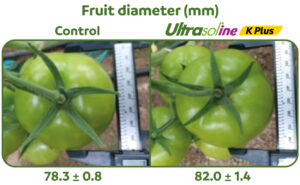The effect of ammonium/nitrate ratio in pH-controlled flowing nutrient solutions on tomato (cv. Angela) yield and quality was studied.
Six different proportions of NH4-N / (NH4+NO3)-N in 6 meq N/l nutrient solutions: 0, 10, 20, 30, 50 and 100% were tested in a greenhouse experiment in Israel. The pH of all the treatments was kept uniform and constant around 6,8 by utilizing shallow one-way-flowing nutrient solutions, chemical composition of the solutions is described in Table 1. Each of the six treatments tested was replicated four times in randomized blocks. The highest marketable yield (4,06 kg/plant) was obtained from the 0 NH4-N treatment (100% NO3), and no considerable decrease in yield was observed in the 10-30% NH4-N treatments (Figure 1).
Significantly lower yields were measured in the 50% (2,99 kg/plant) and 100% (1,63 kg/plant) NH4-N treatments, due to reduced number of fruits per plant and reduced average fruit weight. The high-ammonium-level treatment exerted a detrimental effect on the vegetative development of the plants: decreased leaf area, thinner stem, smaller inflorescences and decreased number of flowers.
The chemical composition of the plants was affected by the high ammonium treatments: more N and less K, Ca and Mg were detected. The application of 10-50% ammonium-N in the nutrient solution increased the percentage of high quality fruit and decreased the percentage of soft fruit after 8 days of storage at 18°C. Low concentrations of 10-30% NH4-N had no detrimental effect on tomato yield, but indeed greatly improved its quality after storage.
Table 1. The chemical composition of the nutrient solutions used in the experiment.
 Figure 1. The effect of NH4-N / (NH4+NO3)-N in the nutrient solution on the marketable yield after harvest (after 2 days of storage at 18°C) and marketable yield after storage (8 days of storage at 18°C). Different letters indicate significant differences between values.
Figure 1. The effect of NH4-N / (NH4+NO3)-N in the nutrient solution on the marketable yield after harvest (after 2 days of storage at 18°C) and marketable yield after storage (8 days of storage at 18°C). Different letters indicate significant differences between values.



